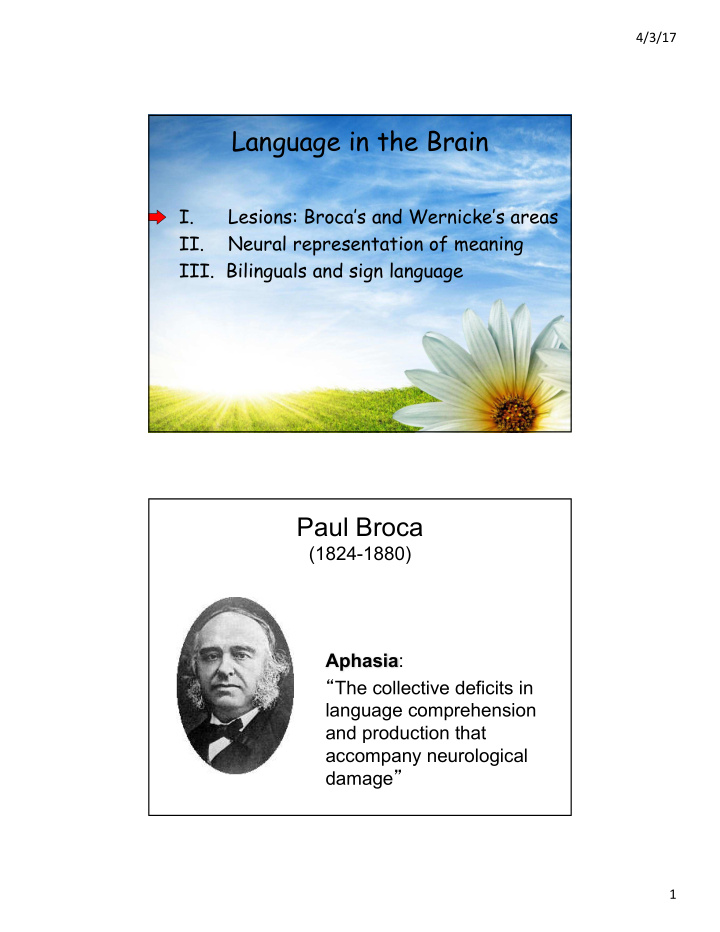



4/3/17 Language in the Brain I. Lesions: Broca’s and Wernicke’s areas II. Neural representation of meaning III. Bilinguals and sign language Paul Broca (1824-1880) Aphasia : “ The collective deficits in language comprehension and production that accompany neurological damage ” 1
4/3/17 frontal lobe Cortex oppervlak links Precentral gyrus (motor cortex) Central sulcus Superior temporal gyrus Inferior frontal gyrus temporal lobe Lateral fissure Figure 20.1 2
4/3/17 (CT scan: computer rostral (anterior) assisted tomography) right left Caudal (posterior) Only damage in the left hemisphere results in aphasia: Paul Broca (1864) “ Nous parlons avec l ’ hemisphere gauche! ” 3
4/3/17 Carl Wernicke (1848-1904) “ I called my mother on the television and did not understand the door. It was not too breakfast, but they came from far to near. My mother is not too old for me to be young. ” Wernicke ’ s aphasia Fluent speech, but nonsensical; loss of ability to understand language 4
4/3/17 frontal lobe Cortex oppervlak links Precentral gyrus (motor cortex) Central sulcus Wernicke ’ s area Superior temporal gyrus temporal lobe Inferior frontal gyrus Lateral fissure (CT scan: computer rostral (anterior) assisted tomography) Wernicke CT scan right left caudal (posterior) 5
4/3/17 Language in the Brain I. Lesions: Broca’s and Wernicke’s areas II. Neural representation of meaning III. Bilinguals and sign language fMRI experiment Tom Mitchell et al “concrete nouns” 6
4/3/17 SCI 10N01 13 7
4/3/17 • A classifier accepts a description of an object and predicts what class it belongs to • Supervised learning works from labeled training examples: apple pear apple apple pear pear and then tests on new examples: What’ s this? • Approach: • Describe each example by values for a set of features <color, size, shape, has-stem, has-leaf, texture,…> <red, small, round, yes, yes, smooth,…> • Training examples must be different from testing examples SCI 10N01 15 Lab 4: ANNs as classifiers Pixel light levels Which digit is it? 8
4/3/17 Neural Network Classifier as • Model of how the brain perceives • Tool for applications like face recog, navigation • Tool for seeing what information is in an experimentally measured neural signal Given 84 nouns, present word, and capture fMRI data Training example is fMRI output and presented word Train on 83 and then test on 1 (repeat 84 times) 9
4/3/17 Remember Lab 5: template matching for face recognition I.e. Compare current fMRI activation pattern to average “tool” pattern and average “building” pattern—choose whichever “template” it is closer to. But is it learning just the appearance of the stimulus (the letter sequence) or its meaning ? 10
4/3/17 11
4/3/17 I.e. can activation patterns for novel words be predicted as combinations of known feature-related activity patterns? Is the neural code for language “compositional”? I.e. define a limited number of “ semantic features ” to characterize each word by its set of feature weights —coordinates in semantic feature space ! 12
4/3/17 13
4/3/17 Remember LAB 3: Eigenfaces are Principal Components of Face Space Represent each face Image by a set of Eigenface weights . à ”Dimensionality Reduction:” Many fewer weights Than pixels! 14
4/3/17 15
4/3/17 MEG experiment to determine WHEN info about specific features appears in the brain: sliding window classification analysis Perceptual features first, semantic features later Sudre 2012 16
4/3/17 Predict fMRI activation by adding up “signatures” for known features 17
4/3/17 Lab 8: General Linear Model! Result: 74% accuracy 18
4/3/17 Sentences > nonwords RESULTS: Different info in different brain regions 19
Recommend
More recommend